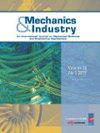柴油机的阀座部件:限制磨损的摩擦学方法
IF 1.2
4区 工程技术
Q3 ENGINEERING, MECHANICAL
引用次数: 1
摘要
在柴油发动机中,气门-座接触是少数容易发生严重退化的非润滑接触之一。进气阀处的材料去除可以证明这种退化。重复燃烧循环(5亿次)和苛刻的操作条件(压力18 MPa)促进了材料的拔出。磨损会导致气体泄漏和发动机故障。这项工作的目标是确定影响这种磨损的主要参数。我们的方法是基于摩擦学三重态和接触内的材料流动,涉及数值和实验方法。动力学模型和气门机构试验台表明,气门开启系统的结构可以激活磨损流。因此,这些流动的限制可以通过控制系统的“整体”几何形状来获得,因此不需要修改材料的特性。同样,阀座-阀接触局部响应的有限元模型强调了接触“局部”几何形状的影响。这种几何形状的变化是限制剪切力的杠杆,从而减少颗粒的撕裂,从而减少磨损。最后,在发动机和专门改装的试验台上进行的试验完成了对退化机制(源流、磨损流等)的理解。从物质流动的角度对磨损表面进行形态学解释,可以理解保护层的形成阶段。促进这种内部流动的一个解决方案是利用燃烧产生的污染物。例如,接触的燃烧过的油,这是先天有害的,在这里成为一个机会。此外,生物柴油燃烧产生的未燃烧的碳氢化合物有助于保护接触。本文章由计算机程序翻译,如有差异,请以英文原文为准。
Valve-seat components in a diesel engine: a tribological approach to limit wear
Within diesel engines, the valve-seat contact is one of the few non-lubricated contacts which is subjected to significant degradation. This degradation is put in evidence by material removal at the intake valve. The material pull out is promoted by the replication of combustion cycles (500 million) and severe operating conditions (pressure 18 MPa). The wear can lead to gas leakage and engine failure. The target of this work was to identify the main parameters affecting this wear. Our approach was based on the tribological triplet and material flows within the contact involving both numerical and experimental approaches. A dynamic model and a valvetrain test bench showed that the wear flows could be activated by the architecture of the valve opening system. Consequently, the limitation of these flows can be obtained by controlling the “global” geometry of the system and therefore without modifying the properties of the materials. In the same way, a finite element model of the local response of the seat-valve contact highlighted the impact of the “local” geometry of the contact. The change of this geometry is a lever to limit the shearing forces which reduces the tearing of the particles and therefore wear. Finally, tests carried out on the engine and on a specifically adapted test bench completed the understanding of degradation mechanisms (source flow, wear flow, etc.). Morphological interpretations of worn surfaces in terms of material flows allowed the understanding of the build-up stages of a protective layer. One solution to promote this internal flow is the use of pollutants from combustion. For example, the burned oil in contact, which is a priori harmful, becomes an opportunity here. In addition, un-burned hydrocarbons from the combustion of biodiesel help to protect the contact.
求助全文
通过发布文献求助,成功后即可免费获取论文全文。
去求助
来源期刊

Mechanics & Industry
ENGINEERING, MECHANICAL-MECHANICS
CiteScore
2.80
自引率
0.00%
发文量
25
审稿时长
>12 weeks
期刊介绍:
An International Journal on Mechanical Sciences and Engineering Applications
With papers from industry, Research and Development departments and academic institutions, this journal acts as an interface between research and industry, coordinating and disseminating scientific and technical mechanical research in relation to industrial activities.
Targeted readers are technicians, engineers, executives, researchers, and teachers who are working in industrial companies as managers or in Research and Development departments, technical centres, laboratories, universities, technical and engineering schools. The journal is an AFM (Association Française de Mécanique) publication.
 求助内容:
求助内容: 应助结果提醒方式:
应助结果提醒方式:


